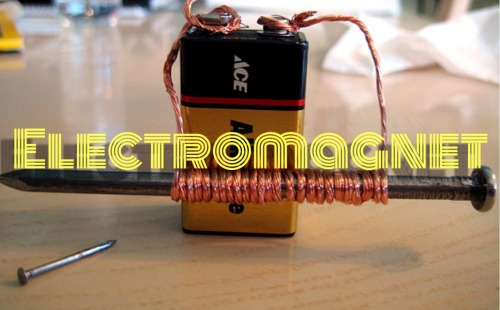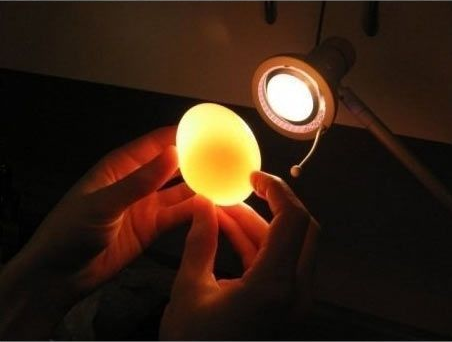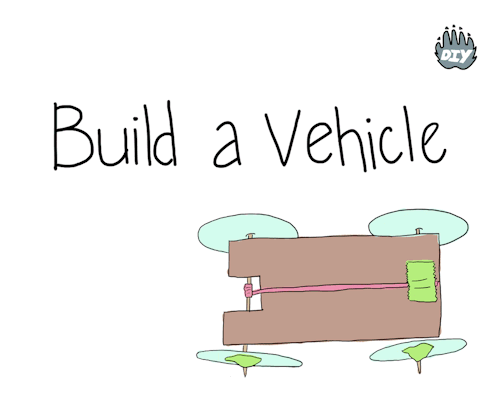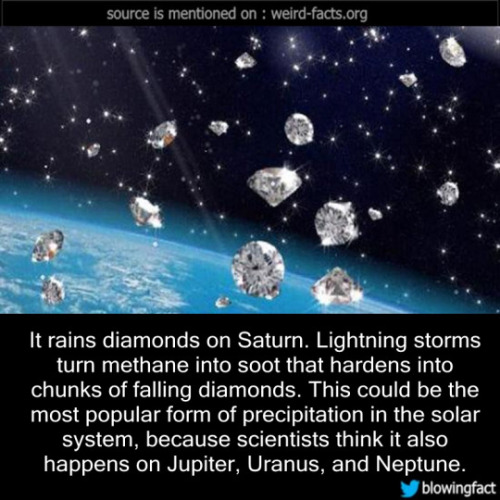Materials: 1. A D Size Battery 2. Paper Clips 3. 3 Feet Of Thin Coated Copper Wire 4. A 3 Inch Large

Materials: 1. A D size battery 2. Paper clips 3. 3 feet of thin coated copper wire 4. A 3 inch large iron nail
Steps: 1. First, leave 8 inches of wire at one end and wrap most of the rest of the wire on the nail ( do not overlap the wires). 2. Next, leave 8 inches of wire at the other end of the nail. 3. Then, remove an inch of the plastic coating from both ends of the wire and attach one end of the wire to one end of the battery and the other wire to the other end of the battery. 4. Finally, put the nail near the paper clips and it should pick them up!
Lesson: Magnets that cannot be turned off like ones on our refrigerators are called permanent magnets. Since the magnet we made can be turned off and on, it is known as an electromagnet. They run on electricity and are only magnetic when the electricity is flowing through the wires, which has the molecules in the nail attract to the metal paper clips.
More Posts from Funscienceexperiments and Others

This Is How Scientists ‘Collect’ Lava

Bill Nye, “The Science Guy”, has some great “home demos” which could certainly be used in the classroom, along with some printable “one sheets”.
#scichat #spedchat #elemchat
Home Demos are found in three categories; life sciences, physical sciences, planetary sciences.
I have added these to Super Science Fair Project Resources
You may also like…
The Surfing Scientist
Hunkin’s Experiments
Windows to the Universe
Welcome to Cosmic Quest







Weekend Project: Do Osmosis with Food
Osmosis is the movement of water across semi-permeable membrane. Experiment with eggs to demonstrate the process of water transport into and out of cells. Get started here!
Newton’s FLYING BEADS! Easy Kids Science Experiments
Watch as Newton’s Beads fly out of a cup as a result of INERTIA!
According to Isaac Newton, an object at rest stays at rest and an object in motion (like the beads) stays in motion with the same speed and in the same direction unless acted upon by an unbalanced force.
By: Whiz Kid Science.
For NASA, Earth Day is Every Day!
With a fleet of spacecraft orbiting our home planet collecting data on everything from the air we breathe to natural disasters that impact our lives, Earth is always in focus. Join us as we celebrate our home with beautiful views from our unique vantage point of space.

On December 17, 1972, the crew of Apollo 17 snapped this iconic image of planet Earth. Dubbed the Blue Marble, this image was taken as Apollo 17 rocketed toward the moon.

On the way to the moon or from the surface of Mars, our spacecraft have photographed the beauty of Earth from many vantage points. In this image, the most powerful telescope orbiting Mars captured this view of Earth and its moon, showing continent-size detail on the planet and the relative size of the moon. The image combines two separate exposures taken on November 20, 2016, by the High Resolution Imaging Science Experiment (HiRISE) camera on our Mars Reconnaissance Orbiter.

In this image taken on July 19, 2013, the wide-angle camera on our Cassini spacecraft captured Saturn’s rings and our planet Earth and its moon in the same frame.
Our Suomi-NPP satellite also observed the Earth at night. Earth’s “night lights” often have a gee-whiz curiosity for the public , but have also served as a tool for fundamental research for nearly 25 years. They have provided a broad, beautiful picture, showing how humans have shaped the planet and lit up the darkness.
You can be mesmerized by the constant swirls in these visualizations of ocean currents. The swirling flows of tens of thousands of ocean currents were captured using the largest computations of their kind ever undertaken, using high-end computing resources at our Ames Research Center.

We’ve all seen iconic photographs of Earth shot by astronauts. But even satellites and robotic spacecraft often get in on the act. The above image, called “Pale Blue Dot,” was taken Voyager 1 in February 1990 from a distance of 4 billion miles.
Our satellites do more than take pretty pictures of Earth. They do everything from measure rainfall to observe weather patterns. The ten satellites in the Global Precipitation Measurement Constellation have provided unprecedented information about rain and snow fall across the entire Earth. This visualization shows the constellation in action, taking precipitation measurements underneath the satellite orbits.

In an homage to Apollo 17′s “Blue Marble” image, Suomi-NPP, a joint NASA-NOAA Earth-observing satellite, made this composite image, by making a number of swaths of Earth’s surface on January 4, 2012.
What’s your favorite aspect of planet Earth? These kids have their own ideas. You can even “adopt” parts of the planet. Which one of the 64,000 locations will you get?
Our home planet is constantly changing, which is why our fleet of Earth-observing satellites continuously monitor the globe, recording every moment of what they see. Luckily for us, many of the views are not only deeply informative but also awe-inspiring.
Make sure to follow us on Tumblr for your regular dose of space: http://nasa.tumblr.com

GIF Tip: Build a Potential Energy Vehicle
Create a vehicle that stores potential energy, then converts it to kinetic energy. A fundamental law of Physics is that energy is never created or destroyed, only changed from one form to another.
For more GIF Tips, check out Megan Leppla’s blog.

Materials: 1. Food Coloring 2. Liquid Dish Washing Soap 3. 3 Tablespoons of Warm Water 4. 1 Tablespoon of Dry Yeast 5. ½ cup of 20-volume hydrogen peroxide from a hair salon 6. Empty 16 ounce Plastic Bottle 7. Small Cup 8. Safety Goggles 9. Tray
Steps: 1. First, put on your safety goggles and place a tray in front of you. 2. Next, pour the hydrogen peroxide in the bottle. (Make sure to have an adult complete this step) 3. Then, add 8 drops of any food coloring of your choice in the bottle. 4. Next, add 1 tablespoon of liquid dish soap into the bottle and swish it to have the materials mix. 5. Then, combine the warm water and yeast together in a separate small cup and mix for 30 seconds. 6. Finally, place the bottle in the tray and pour the yeast water mixture into the bottle.
Lesson: While doing this experiment, foam appears having each tiny foam bubble filled with oxygen. The yeast acted as a catalyst or helper to remove the oxygen from hydrogen peroxide. If you touch the bottle, you notice that it is warm. That means your experiment made a reaction called exothermic reaction because it creates heat.
The Feminine Face of Space
Museum of Cosmonauts, 1984 - 2015








Not all shadows are black. The Colored Shadows exhibit is a discovery of the colors hidden in white light. Red, green and blue spotlights shine on a wall. The wall is white because red, blue and green light combine to make white light. These colors are often called the additive primary colors. As you walk (or dance) between the lights and the wall, your body casts three different shadows.
-
 unabashedbarbarianpeace liked this · 2 years ago
unabashedbarbarianpeace liked this · 2 years ago -
 colorfulcollectorpirate liked this · 3 years ago
colorfulcollectorpirate liked this · 3 years ago -
 gustavolemosrocha-blog liked this · 5 years ago
gustavolemosrocha-blog liked this · 5 years ago -
 urgaanlove liked this · 6 years ago
urgaanlove liked this · 6 years ago -
 funscienceexperiments reblogged this · 7 years ago
funscienceexperiments reblogged this · 7 years ago -
 irepair247-blog liked this · 8 years ago
irepair247-blog liked this · 8 years ago -
 funscienceexperiments reblogged this · 8 years ago
funscienceexperiments reblogged this · 8 years ago -
 funscienceexperiments reblogged this · 9 years ago
funscienceexperiments reblogged this · 9 years ago -
 girlscoutmonster-blog liked this · 9 years ago
girlscoutmonster-blog liked this · 9 years ago -
 vintage-cate liked this · 9 years ago
vintage-cate liked this · 9 years ago -
 funscienceexperiments reblogged this · 9 years ago
funscienceexperiments reblogged this · 9 years ago
Hi everyone! I'm Ashley P. and I'm a Girl Scout who wants to make a difference in the world. Currently, I've been working on my Gold Award Project, which is a project where Girl Scouts solve an issue in their community to earn the Gold Award. The Gold Award is the highest award a Girl Scout can achieve. In my project, I'm addressing the issue on how there are a lack of women in the STEM field by creating a program to do fun science experiments with younger girls. Also, I constructed this blog for parents and children to do exciting and simple experiments with their kids to spark a passion in this subject like what happened to me as a child. I hope you enjoy and try to accomplish the experiments I post! Also, please have adult supervision while completing these experiments.
210 posts